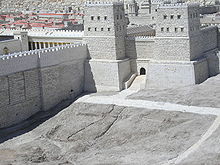Antonia Castle
The castle Antonia was an ancient fortress in Jerusalem , by Flavius Josephus described in detail.
history
Antonia Castle was in a crucial position in the defense of Jerusalem, as almost all attacks on Jerusalem came from the north. In addition, the Antonia could be used to control the events on the temple square.
A fortress, the so-called Haenael Tower, was built here as early as the time of the first temple . After the exile, the city and temple were rebuilt under Nehemiah , in the course of which the fortress, which had meanwhile been destroyed, was also rebuilt. In 167 BC The fortress was destroyed by the Seleucids , but a new fortress was built in the same place. This was henceforth called Baris ("castle"). Herod the Great expanded it into a splendid palace fortress, where he lived until 23 BC. Before he moved to the new royal palace on the west hill. In honor of his patron Antonius , he named the fortress from then on Antonia Castle. After Herod's death, a cohort of the Xth Legion was stationed there. In 66 it was set on fire by the Zealots during the Jewish War . After the city was conquered by Roman troops in 70 , the fortress was demolished on the orders of Titus .
Location and architecture


The Antonia Castle rose on a 25 meter high rock plateau measuring 150 × 90 meters. Four massive towers reinforced the corners. Each of them was 25 meters high, the southeast tower even 35 meters. On the outside, Antonia Castle was a strong fortress; on the inside, it was a palace with representative and living rooms, baths, barracks and arsenals.
Christian tradition
Christian tradition sees Antonia Castle as the place where Jesus Christ is said to have been sentenced to death by Pontius Pilate . It is questionable whether the verdict was actually passed in Antonia Castle. The term Praetorium ( Jn 18.28 EU ) is more likely to refer to the former royal palace on the west hill. In view of the Passover festival and the feared uprising in Jerusalem , there is a very good chance that Pilate conducted an interrogation and condemnation in the heavily fortified Antonia Castle.
After this place was not associated with the trial of Jesus for over 1100 years, this happened for the first time with Theodericus, who correctly localized the Antonia in 1172, following the information given by Josephus. Around 1180 an anonymous author identified the Antonia with the official residence of Pilate. During the time of the crusaders a place of remembrance (a small domed structure) was built, the “Chapel of Rest”, which Ernoul explained: “There, they say, Christ rested when he was led to the crucifixion ...” That is why the Way of the Cross began here ( Via Dolorosa ) of the crusaders, which led over the Temple Mount to the Church of the Holy Sepulcher.
literature
- Immanuel Benzinger : Antonia . In: Paulys Realencyclopadie der classischen Antiquity Science (RE). Volume I, 2, Stuttgart 1894, Col. 2566.
- Max Küchler : Jerusalem. A handbook and study guide to the Holy City. Vandenhoeck & Ruprecht, Göttingen 2007, ISBN 978-3-525-50170-2 .
- Ehud Netzer : The palaces of the Hasmoneans and Herod the great . Verlag Philipp von Zabern, Mainz 1999, ISBN 3-8053-2011-6 .
Web links
Coordinates: 31 ° 46 ′ 48.3 " N , 35 ° 14 ′ 2.1" E
